
Ski: 2019-2020 Nordica Santa Ana 110, 177 cm
Available Lengths: 161, 169, 177 cm
Blister’s Measured Tip-to-Tail Length: 175.4 cm
Blister’s Measured Weight per Ski: 2076 & 2078 grams
Stated Dimensions: 140-110-129 mm
Blister’s Measured Dimensions: 140.9-109.4-131.7
Stated Sidecut Radius: 16.5 meters
Measured Tip & Tail Splay (ski decambered): 63 mm / 44 mm
Measured Traditional Camber Underfoot: ~4 mm
Core: Poplar/Beech/Balsa + Titanal (2-layer) + Carbon Stringers + Fiberglass Laminate
Base: Sintered
Factory Recommended Mount Point: -9.0 cm from center; 78.7 cm from tail
Boots / Bindings: Tecnica Mach 1 Pro W / Marker Griffon
Test Locations: Revelstoke Mountain Resort, BC; Taos, NM
Days Skied: 7
[Note: Our review was conducted on the 18/19 Santa Ana 110, which was not changed for 19/20, apart from graphics.]
Intro
The Santa Ana series is the women’s equivalent of Nordica’s very good Enforcer line. The two series share a similar construction and rocker profiles, and we’ve been impressed with the Santa Ana 100 in the past.
The Santa Ana 110 is the widest ski in the Santa Ana series, and the widest women-specific ski Nordica Makes.
Here’s What Nordica says about the Santa Ana 110:
“Building on the success of the Santa Ana 100, the Santa Ana 110 is the newest—and widest—addition to the Santa Ana collection. Its 110mm waist offers additional confidence and stability in soft snow. To minimize weight and maximize fun, the Santa Ana 110 features a balsa wood core with carbon sandwiched between two sheets of metal. This design also enhances edge hold for powerful and precise turns while dampening vibrations for a smooth and predictable ride. And to maximize floatation in powder and boost performance in variable conditions, it sports a high rise tip and tail rocker profile. For soft snow and good times, choose the Santa Ana 110.”
Nordica very much emphasizes the soft-snow orientation of the Santa Ana 110, and this is something we’re going to be paying close attention to in our review. Because, as you’ll see below, we have pretty high hopes for the variable- and firm-condition performance of the Santa Ana 110. Here’s why:
Shape / Rocker Profile
The Santa Ana 110 has a lot more camber underfoot than the Blizzard Sheeva 11 (a ski we’ll be comparing to the Santa Ana 110), and the Sheeva 11 has deeper tip and tail rocker lines. So our prediction is that the Sheeva 11 will feel a bit surfier than the Santa Ana 110. Compared to the Line Pandora 110, the Santa Ana 110 has significantly more tail splay, and more splayed-out tips (the Pandora 110 has a fairly deep tip rocker line, but it doesn’t curve up till near the tip of the ski). Overall, the Santa Ana 110’s rocker profile looks very much like that of the Enforcer 110.
Flex Pattern
Hand flexing the skis, here’s how we’d characterize the flex pattern of the Santa Ana 110:
Tips: 6.5
Shovels: 7.5-8.5
In Front of Toe Piece: 9.5
Underfoot: 10
Behind Heel Piece: 9.5-8.5
Tails: 8.5-9
While it has accessible tips, the fact is that the Santa Ana 110 has a stout flex pattern. When compared directly against the 185 cm Nordica Enforcer and Enforcer 110, the tails of the Santa Ana 110 are noticeably stiffer than the Enforcer 100, and they are slightly stiffer than the Enforcer 110’s.
The shovels of the Santa Ana 110 feel very much in line with the Enforcer 110’s, and both skis feel very similar up front compared to the Enforcer 100 (though if anything, the Santa Ana 110 is slightly stiffer).
Point is, the Santa Ana 110 is not a softer version of the Enforcer 110.
Compared to the 172 cm Blizzard Sheeva 11:
Both skis are stout underfoot, but the Sheeva 11 is a bit softer at the very tip of the ski, and definitely has a softer tail. (The Sheeva 11 is also much lighter, at ~1810 g per ski in the 172 cm.)
Weight
The Santa Ana 110 is coming in heavier than most of its competition, and we’re actually pretty excited about this, since that additional weight ought to give the ski greater stability in difficult conditions, while the rocker profile of the ski ought to keep it pretty maneuverable even in tighter spots and deeper snow.
For reference, here are a few of our measured weights for a few other notable skis:
2076 & 2078 Nordica Santa Ana 110, 177 cm
1806 & 1821 Blizzard Sheeva 11, 172 cm
1803 & 1840 Liberty Genesis 116, 174 cm
1822 & 1826 Liberty Genesis 106, 171 cm
1842 & 1891 Line Pandora 110, 172 cm
1882 & 1901 Icelantic Maiden 111, 177 cm
1955 & 1955 4FRNT Hoji W, 179 cm
Keep in mind that a number of the skis listed here are shorter than the 177 cm Santa Ana 110. But still, we suspect that the additional weight of the Santa Ana 110 combined with its accessible shape might make this ski more versatile across a broader range of conditions than some of the other skis listed here.
Bottom Line (For Now)
With a stout flex pattern, solid weight, and generous rocker profile, the Santa Ana 110 looks like it has all the ingredients to be a capable-but-playful powder ski. And if its performance reflects that of its brother, the Enforcer 110, we expect it to also be a pretty versatile powder ski that could suit a wide variety of skiers.
We’re actually getting time on the Santa Ana 110 right now in Revelstoke, so stay tuned for updates.
NEXT: The Full Review
Intro
I spent 6 days on the Nordica Santa Ana 110 at Revelstoke Mountain Resort where conditions ranged from light, deep powder to heavy powder and crud, soft to firm groomers, soft and hard bumps, and completely saturated (rain on snow) powder. I also spent a day on the Santa Ana 110 at Taos Ski Valley, where conditions included soft and firm corduroy, and soft and firm bumps. Here’s what I found:
Chop
My very first turns on the Santa Ana 110 were made around mid-mountain at Revelstoke. The mountain had received some snow overnight, and the groomers were covered in about 6 inches of fresh chop. The Santa Ana 110 felt extremely stable charging through the chop with no signs of tip flop, and I wasn’t able to find its speed limit in these conditions.
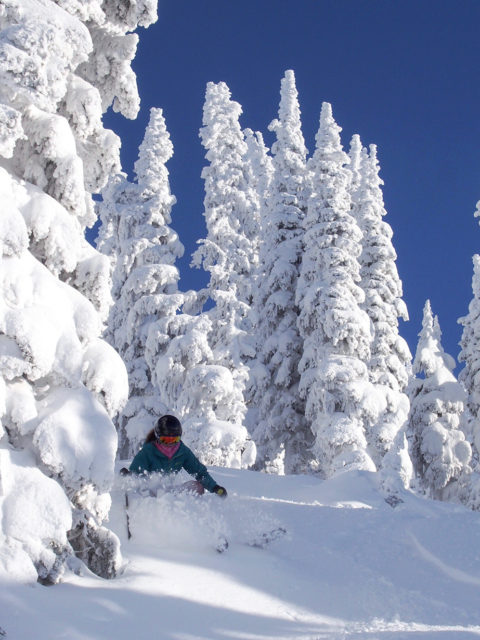
I had plenty more chances to test the Santa Ana 110 in chop over the course of my 6 days in Revelstoke, and my initial conclusions never changed. Whether the chop was light or heavy, these skis felt stable and easy to control.
Powder
The Santa Ana 110 is a bit heavier than other similar skis that I’ve tested, so I wasn’t too surprised when they didn’t feel quite as surfy in powder as skis like the lighter (and more heavily rockered) Armada VJJ. I think bumping the bindings forward might make the Santa Ana 110 feel a little looser, so I’ll update this review if I notice much of a difference with a more forward mount.
But with all that said, I was still very happy with the Santa Ana 110’s float, it just felt a little more locked in / less surfy than the VJJ (which is a very playful ski).
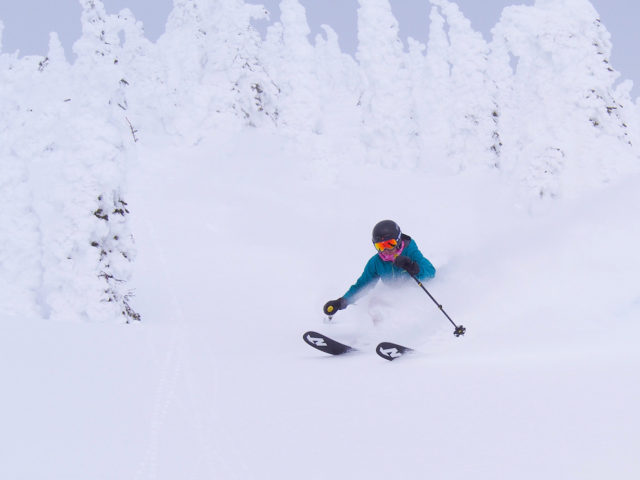
When skiing heavy, wet snow, the Santa Ana 110 felt most at home in open terrain where I could make big, fast turns. In lighter powder, it was easy to steer the Santa Ana 110 through tight chutes or let them run in the open bowls, but in heavier/denser snow, more work was required to maneuver the skis. I’d be interested to try the 172 Santa Ana 110 as I imagine it would be a bit more maneuverable than the 177 cm in tight spots.
Groomers
I didn’t spend much time on groomers in Revelstoke, but when I did, the snow was hard and fast, and I was able to easily hold an edge with the Santa Ana 110.
I did have one day at Taos where my time was split between groomers and soft moguls. On soft, fresh corduroy, these skis made big and small turns equally well, and were so smooth that I had no idea I was skiing much faster than normal. Later in the day when the groomers were a mixture of firm snow and randomly placed bumps, the Santa Ana 110 felt easy to maneuver and also stable — they didn’t get knocked around easily in the variable conditions.
Moguls
The majority of the moguls at Revelstoke were spaced out nicely on the wide open trails, but in the trees, some deeper moguls developed that I found a bit hard to navigate on the long, stiff 177 cm Santa Ana 110. Granted, I think I would have struggled a bit with this terrain no matter what ski I was on, but I found it challenging to scrub speed on the 177 cm Santa Ana 110 in this sort of tight terrain.
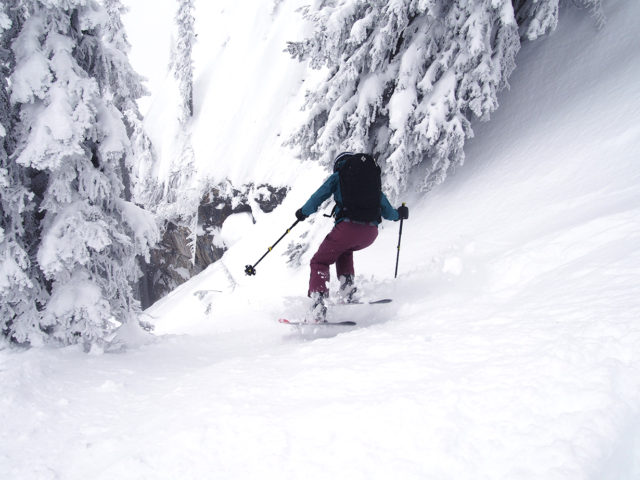
Later in the week as my legs started to get tired and I found myself getting knocked in the backseat, these skis challenged me. With tired legs, the 177s could be a handful or me, especially in tight trees.
At Taos, I spent some time on a run with nice, soft moguls and these skis again felt just a little long and heavy to really excel in the bumps. This is another area where I’m curious if a more forward mount would make the Santa Ana 110 feel more maneuverable. I’ll update this review if I notice any significant change in the ski’s mogul performance with a more forward mount.
Comparisons
As my go-to ski for the last 4 years, the Pandora 110 is a very good reference point when judging the Santa Ana 110. To start with the obvious, I tested the Santa Ana 110 in the 177 cm length, which definitely feels longer than the 172 cm Pandora 110 (which is the longest length of the Pandora that Line makes).
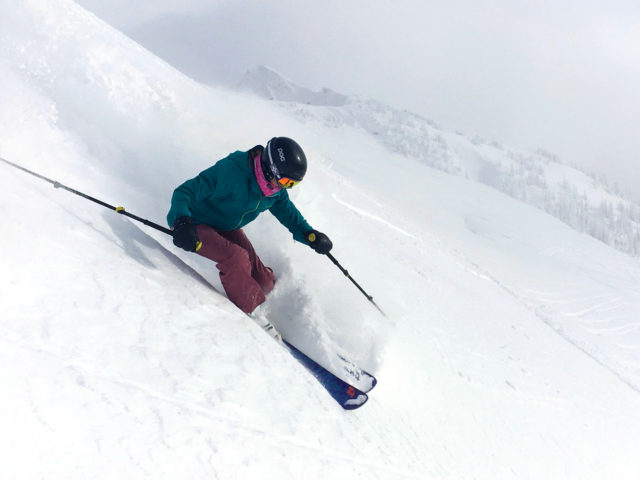
I haven’t skied a long, stiff ski like the Santa Ana 110 in a long time, and I was a bit nervous at first, but after a few turns, I was happy to have the extra length that is rare to find in women’s skis. Like the Pandora 110, the Santa Ana 110 performed well for me in powder, but the Santa Ana 110 outperformed the Pandora 110 on groomers, and fared just slightly better in chop. I think the Santa Ana 110 is well on its way to becoming my new gold standard for all-around performance.
The Santa Ana 110 doesn’t float on top of powder or turn as easily in tight trees as the Armada VJJ, but the Santa Ana 110 works much better as an all-around, all-conditions ski. This is especially true on groomers and in chop where the VJJ has a tendency to get knocked around a bit.
Icelantic Maiden 111, 177 cm
I have a fairly limited amount of time on the Maiden 111, but their very soft tips in chop and crud were memorable. The Santa Ana 110 definitely provided more stability than the Maiden 111 on groomers and in chop / crud.
Bottom Line
The Nordica Santa Ana 110 is an excellent women’s all-mountain ski. It provides excellent stability in crud / chop, it turns when needed, and it has simply been fun doing everything I asked of it.
While I imagine I’d get along well with the 172 cm version of the ski (since, as we pointed out in our First Look, this is a pretty stout ski) — and the 177 cm Santa Ana 110 can feel a bit long in tight spots — it is cool that Nordica offers the longer length.
I think the Santa Ana 110 is ideal for advanced to expert skiers looking for a ski that can keep up with them. I know a number of women who prefer to ski on men’s skis for various reasons, but I would recommend that they check out the Santa Ana 110 if they’re looking for a very capable, wider, all-mountain ski.
Blister reviewer, Kara Williard, has also been skiing the Santa Ana 110, and she’ll soon be offering her take on the ski.
NEXT: Rocker Profile Pics
(Click on images to expand)


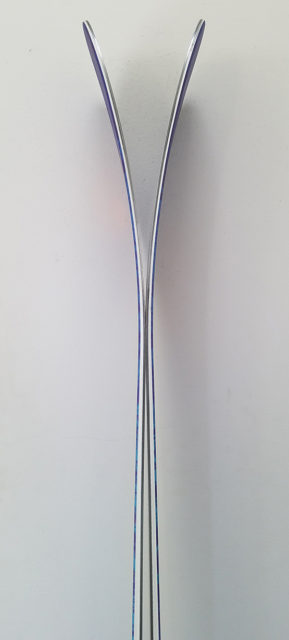
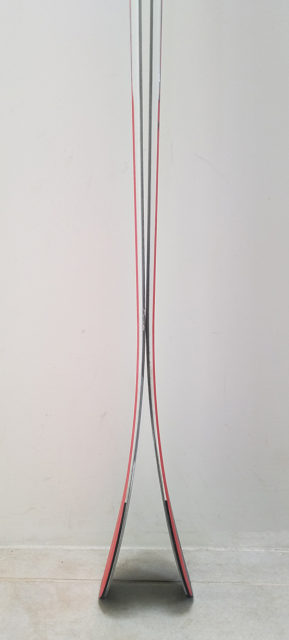



would like your follow up on the Santa Anna at Revelstoke.
Well then you’re in luck! :)
Great review, thanks! Has anyone played around with the mount points on the Santa Ana 110? Local shop has mis-mounted my wife’s new 177cm Santa Ana 110s at +0.5cm from the recommended line. She used them in 30cm fresh and was getting a lot of tip dive. She’s 5’8 and 138 lbs. We are thinking about moving the mount back 1cm (minimum gap for screws?) to -0.5cm but wonder if anyone has tried mounting them behind the line?
Awesome review :) I’m looking for a new pair of resort skis to replace my beloved Armada TSTW’s… they were my 1 ski quiver but are close to the end of their lives.
I’m a bit torn… right now I’m considering:
– these skis (110mm Santa Ana)
– Nordica Santa Ana 100mm
– Black Crows Atris Birdie
– Icelantic Maiden 101mm
I spend most of my time skiing pow and in the trees, but I love to rip a few groomers now and then. Wondering if you have any thoughts for me! Cheers!
I highly recommend the Nordica Santa Ana 100. They are my go to all mountain ski. Winter Park resort is my home mountain where there are plenty of bumps but also amazing tree skiing. The Santa Ana 100 is a nimble, yet solid ski that takes me anywhere comfortably. Weight is important to me because I am getting older and I don’t want to work too hard to control a ski in tight spaces. On the other hand, the ski also needs to feel stable while arcing high speed turns. The Nordic Santa Ana checks both boxes for me. In fact I enjoy them so much, I am planning to add the 110 to my quiver. I previously skied the Blizzard Dakota (femail version of the Cochise). For reference I am an expert skier, 5’7″, 145 lb, 55 years old.